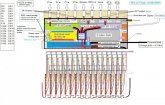Solarfun4jim
Solar seduced :-)
Totally different world to me...so just picking up info at present....
1/ If looking to use mosfets to switch loads up to 64V64A (>4Kw) , would good practice dictate using a single power mosfet with large heatsink or paralleling several fets to achieve the parameters needed?
2/ Any recommendations on a control chip that can control 144 mosfets, each 1/10th sec, using data input reference of 16 cells? Along with this, are there any recommended websites that would produce programming code if you set the parameters?
Just exploring possibilities.
1/ If looking to use mosfets to switch loads up to 64V64A (>4Kw) , would good practice dictate using a single power mosfet with large heatsink or paralleling several fets to achieve the parameters needed?
2/ Any recommendations on a control chip that can control 144 mosfets, each 1/10th sec, using data input reference of 16 cells? Along with this, are there any recommended websites that would produce programming code if you set the parameters?
Just exploring possibilities.





